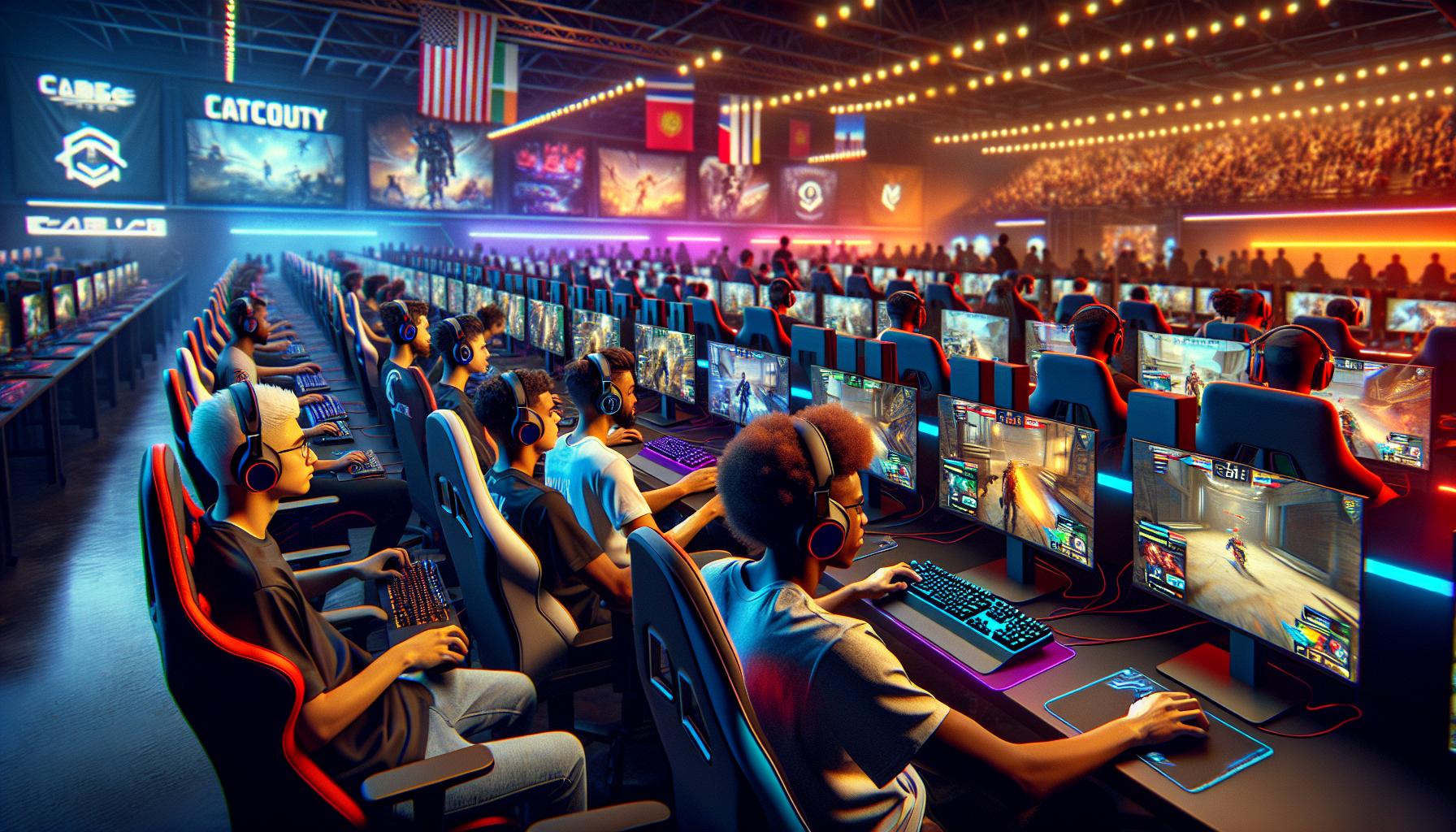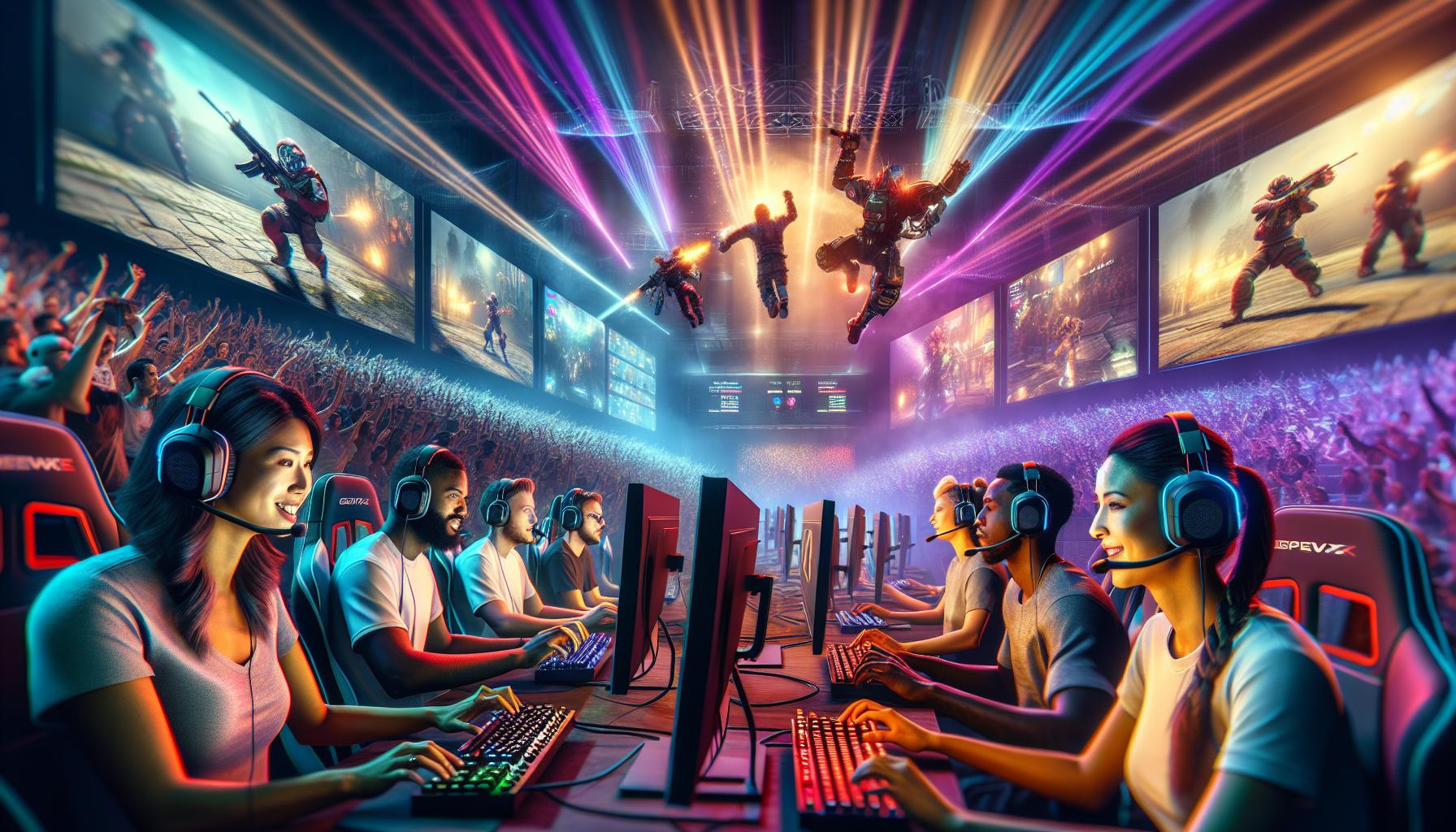Key Takeaways
- Origins in the 1970s: Esports began as a niche hobby with simple arcade games like Pong, laying the groundwork for organized competitions.
- Internet Impact: The rise of the internet in the 1990s allowed global connectivity for players, fostering online competitions and expanding the esports community.
- Professionalization: The early 2000s saw the establishment of professional leagues and major tournaments, legitimizing esports as a serious competitive platform.
- Streaming Revolution: Platforms like Twitch transformed esports viewership, offering live broadcasts and community engagement, significantly increasing audience numbers.
- Mainstream Integration: Esports attracted major sponsorships and investments from corporations, solidifying its status within popular culture and entertainment.
- Future Trends: Upcoming developments include the rise of mobile gaming, enhanced streaming technology, and increased regulatory efforts, promising a more inclusive and commercially viable esports landscape.
Esports has evolved from a niche hobby into a global phenomenon, captivating millions and reshaping the landscape of competitive entertainment. What began in the 1970s with simple arcade tournaments has transformed into a multi-billion dollar industry, complete with professional leagues, sponsorships, and massive live events.
As technology advanced, so did the complexity and popularity of competitive gaming. The rise of the internet fueled this growth, connecting players and fans across the globe. Today, esports encompasses a wide range of genres and platforms, drawing in diverse audiences and creating new opportunities for players and content creators alike. Understanding the history of esports reveals not just the milestones of gaming but also the cultural shifts that have accompanied its rise.
History of Esports
Esports encompasses competitive video gaming where players or teams compete in organized events for recognition, prizes, and fan support. The roots of esports trace back to the early 1970s, with simple games like Pong attracting small gatherings. By the 1980s, tournaments began emerging, notably the Space Invaders Championship in 1980, which drew significant attention.
The 1990s marked a turning point. Titles like Doom and StarCraft gained traction within gaming communities, fostering online competitions. The introduction of the internet changed the landscape, enabling players to compete globally. By the late 1990s, platforms such as Battle.net allowed for large-scale participation.
The early 2000s solidified esports, with the establishment of professional leagues and increased media coverage. Major tournaments like the World Cyber Games and Electronic Sports World Cup gained viewership and sponsorship, amplifying esports’ visibility. Further advancements in gaming technology and broadcasting platforms, such as Twitch, transformed esports into a spectator sport, drawing millions of viewers.
Today, esports thrives as a multi-billion dollar industry, consisting of diverse genres including first-person shooters, real-time strategy games, and multiplayer online battle arenas. The rise of sponsorships and partnerships with mainstream brands solidified its position in global entertainment. Esports continues to evolve, pushing boundaries and enhancing the gaming experience for players and fans alike.
Early Beginnings

Esports traces its roots to its early days in the 1970s, marked by simple gaming experiences and grassroots competitions. The foundational elements from this era laid the groundwork for future developments in competitive gaming.
Arcade Gaming Era
Arcade machines became popular in the late 1970s and early 1980s. Titles like Pong and Space Invaders allowed players to compete for high scores, creating a burgeoning community. Players often gathered in arcades to challenge each other’s skills, fostering a competitive spirit. The 1972 release of Pong sparked interest in gaming as a form of entertainment. By 1980, large-scale competitions began to surface, such as the Space Invaders Championship, which drew thousands of participants and spectators alike, signaling the beginning of organized gaming events.
Emergence of Competitive Play
The 1990s marked a significant shift as multiplayer gaming gained traction. Titles such as Doom and StarCraft encouraged players to compete online, thanks to the emergence of internet connectivity. The first Doom tournaments in 1994 allowed players to face off in a networked environment, setting precedents for future competitions. By the late 1990s, organized tournaments began to expand, supported by early gaming communities. Events like the Cyberathlete Professional League (CPL), founded in 1997, helped solidify esports as a legitimate competitive platform, attracting players and fans across the globe.
The Rise of Online Gaming

The emergence of online gaming played a pivotal role in elevating esports from a niche pastime to a mainstream phenomenon. Technological advancements and the proliferation of the internet connected gamers globally, fostering competitive environments.
LAN Tournaments
LAN (Local Area Network) tournaments represented a significant step in the evolution of competitive gaming. These events allowed players to connect directly and compete in real-time, eliminating lag and fostering a communal atmosphere. Early LAN tournaments became popular in the late 1990s, with titles like StarCraft and Counter-Strike at the forefront. Events such as DreamHack, established in 1994, attracted thousands of participants and spectators, setting the stage for larger competitions. LAN events not only enhanced the competitive experience but also built strong community ties among players.
Birth of Major Competitions
The late 1990s and early 2000s witnessed the birth of major esports competitions that defined the industry’s structure. The Cyberathlete Professional League (CPL) debuted in 1997, introducing professional tournament play and formal prize distributions, which enticed players seeking recognition. Similarly, the World Cyber Games, launched in 2000, became known as the “Olympics of esports,” attracting international competitors and audiences. These competitions laid the groundwork for major brands and sponsors to invest in esports, further legitimizing it as a serious competitive platform.
Technological Advancements

Technological advancements significantly influenced the growth and popularity of esports. Innovations in streaming, broadcasting, and social media transformed how games are played and viewed, connecting millions of fans and players.
Streaming and Broadcasting
Streaming platforms revolutionized esports, enabling live broadcasts of competitions and casual play. Twitch, launched in 2011, became the primary platform, amassing over 15 million daily active users by 2023. It offered real-time interaction between gamers and audiences, fostering a sense of community. YouTube Gaming also emerged, providing additional avenues for viewing and sharing gameplay. Major esports tournaments, such as The International and League of Legends World Championship, attracted viewership numbers exceeding 40 million, solidifying esports as a prominent entertainment medium. Broadcasting on television has grown, with networks like ESPN covering major events and introducing esports to broader audiences.
The Role of Social Media
Social media platforms, including Twitter, Facebook, and Instagram, played a critical role in promoting esports. They facilitate instant communication, allowing teams and players to connect with fans directly. Organizations such as FaZe Clan and Team SoloMid utilize social media to engage fan bases and share content, enhancing brand visibility. In 2022, social media interactions during esports events peaked, with platforms reporting up to 10 million interactions per hour. These interactions boost event awareness and cultivate broader interest in competitive gaming, contributing to the industry’s global expansion.
The Mainstream Acceptance
Esports gained significant traction in the mainstream through sponsorship and investment, alongside its integration into popular culture. This shift marked a transformative period for competitive gaming.
Sponsorship and Investment
Sponsorships and investments surged as brands recognized the lucrative potential of esports. Major corporations like Coca-Cola, Intel, and Mercedes-Benz began investing in teams and tournaments, elevating the industry’s profile. By 2023, global sponsorship revenue in esports reached approximately $1.8 billion. These investments not only provided financial support for teams but also increased visibility. Professional leagues attracted media rights deals worth millions, further legitimizing esports as a profitable enterprise.
Esports in Popular Culture
Esports permeated popular culture, evident in mainstream media coverage and celebrity involvement. Popular franchises, including Fortnite and Call of Duty, collaborated with musicians and influencers to create crossover events that garnered millions of viewers. Films and documentaries focused on competitive gaming enhanced public interest and recognition. By 2023, esports celebrities like Tyler “Ninja” Blevins became household names, appearing on talk shows and fostering connections with traditional sports figures. Video game competitions now attract audiences comparable to traditional sporting events, solidifying esports’ position in the cultural landscape.
Future of Esports
The future of esports appears promising, characterized by rapid growth and innovation. Emerging trends and predictions indicate significant developments that could reshape the industry.
- Increased Investment
Major brands and investors increasingly recognize the value of esports, creating opportunities for further financial growth. Sponsorship revenue exceeded $1.8 billion in 2023, with expectations for continued growth as companies expand their involvement.
- Expansion of Mobile Gaming
Mobile gaming has gained traction, with titles like PUBG Mobile and Arena of Valor leading competitive play on handheld devices. This trend attracts a broader audience and new participants, enhancing the inclusivity of esports particularly in regions with limited access to PCs and consoles.
- Enhanced Streaming Technology
Streaming platforms such as Twitch and YouTube Gaming continuously innovate, improving the viewer experience. Enhanced features could include augmented reality (AR) elements during live broadcasts, increasing audience engagement and interaction.
- Integration with Traditional Sports
Collaborations between traditional sports organizations and esports teams emerge as a growing trend. Teams like the New York Knicks and FC Barcelona have introduced esports divisions, bridging the gap between competitive gaming and traditional athletics.
- Diverse Game Genres and Formats
A wider array of game genres, including simulation, card games, and even educational gaming, could diversify competitive gaming. The inclusion of various formats allows different skill sets and attracts varied players and spectators.
- Rise of Female Players and Inclusivity Initiatives
Efforts to promote female representation in esports result in more all-female tournaments and initiatives that encourage diversity. Visibility of female players enhances the community’s inclusiveness, expanding the overall gaming landscape.
- Regulatory Growth
As esports matures, regulatory bodies may establish standardized rules and ethics for competitive play. This development could enhance legitimacy, ensuring fair play and protecting player rights, which may attract more traditional sponsors.
- Greater Global Reach
Countries like India and Brazil show increasing interest in esports, contributing to expanding global audiences. Local tournaments in these regions could help nurture talent and elevate esports’ international profile.
These trends indicate a dynamic future for esports, with the potential to transform the gaming landscape into a more inclusive, diverse, and commercially viable sector in the years to come.
Esports Has Evolved Into a Vibrant And Influential Part of Global Culture
Esports has evolved into a vibrant and influential part of global culture. Its journey from simple arcade competitions to massive international tournaments showcases the dedication and passion of players and fans alike. As technology continues to advance and the industry attracts new investments, esports is set to reach even greater heights.
The integration of esports into mainstream media and its collaboration with traditional sports highlight its widespread appeal. With an ever-growing audience and the emergence of diverse game genres, the future holds exciting possibilities for esports. It’s clear that competitive gaming is not just a trend; it’s a lasting phenomenon that will shape entertainment for years to come.